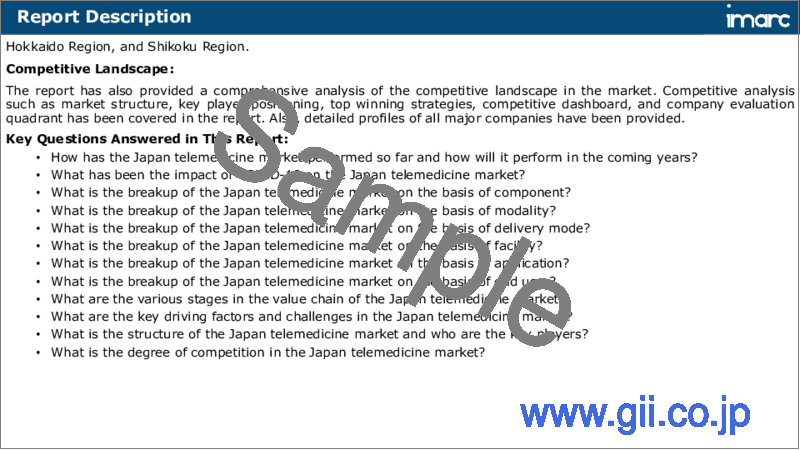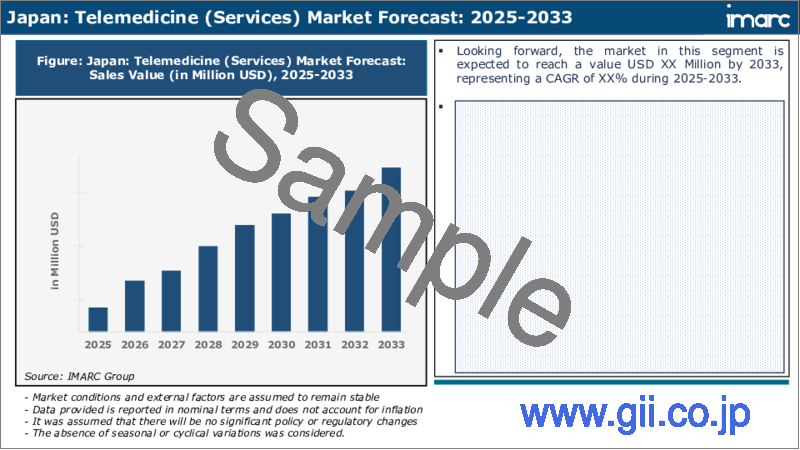|
|
市場調査レポート
商品コード
1609734
日本の遠隔診療市場レポート:コンポーネント、モダリティ、提供モード、施設、用途、エンドユーザー、地域別、2025年~2033年Japan Telemedicine Market Report by Component, Modality, Delivery Mode, Facility, Application, End User, and Region 2025-2033 |
||||||
カスタマイズ可能
|
|||||||
| 日本の遠隔診療市場レポート:コンポーネント、モダリティ、提供モード、施設、用途、エンドユーザー、地域別、2025年~2033年 |
|
出版日: 2024年12月05日
発行: IMARC
ページ情報: 英文 120 Pages
納期: 5~7営業日
|
- 全表示
- 概要
- 目次
日本の遠隔診療市場の市場規模は2024年に52億米ドルに達しました。今後、IMARC Groupは、2025年から2033年にかけて16.2%の成長率(CAGR)を示し、2033年には200億米ドルに達すると予測しています。慢性疾患に罹患しやすい高齢者の増加、急速な技術進歩、都市化の進展、スマートフォンの普及、健康管理や医療へのアクセスのためのデジタルソリューションに対する需要の増加、ライフスタイルの変化、さまざまな政府イニシアチブの実施などが、市場を牽引する主な要因となっています。
本レポートで扱う主な質問
- 日本の遠隔診療市場はこれまでどのように推移し、今後どのように推移するのか?
- COVID-19が日本の遠隔診療市場に与えた影響は?
- 日本の遠隔診療市場のコンポーネント別の内訳は?
- 日本の遠隔診療市場のモダリティ別の内訳は?
- 日本の遠隔診療市場の提供モード別の内訳は?
- 日本の遠隔診療市場の施設別の内訳は?
- 日本の遠隔診療市場の用途別の内訳は?
- 日本の遠隔診療市場のエンドユーザー別の内訳は?
- 日本の遠隔診療市場のバリューチェーンにはどのような段階がありますか?
- 日本の遠隔診療市場の主な促進要因と課題は何か?
- 日本の遠隔診療市場の構造と主要プレーヤーは?
- 日本の遠隔診療市場の競合の程度は?
目次
第1章 序文
第2章 調査範囲と調査手法
- 調査の目的
- ステークホルダー
- データソース
- 市場推定
- 調査手法
第3章 エグゼクティブサマリー
第4章 日本の遠隔診療市場:イントロダクション
- 概要
- 市場力学
- 業界動向
- 競合情報
第5章 日本の遠隔診療市場情勢
- 過去および現在の市場動向(2019年~2024年)
- 市場予測(2025-2033)
第6章 日本の遠隔診療市場:コンポーネント別の内訳
- 製品
- サービス
第7章 日本の遠隔診療市場:モダリティ別の内訳
- リアルタイム
- 保存と転送
- その他
第8章 日本の遠隔診療市場:提供モード別の内訳
- ウェブ/モバイル
- コールセンター
第9章 日本の遠隔診療市場:施設別の内訳
- 遠隔病院
- テレホーム
第10章 日本の遠隔診療市場:用途別の内訳
- 遠隔皮膚科
- 遠隔放射線診断
- テレサイキアトリー
- テレパソロジー
- 遠隔心臓病学
- その他
第11章 日本の遠隔診療市場:エンドユーザー別の内訳
- プロバイダー
- 支払者
- 患者
- その他
第12章 日本の遠隔診療市場:競合情勢
- 概要
- 市場構造
- 市場プレーヤーのポジショニング
- 主要成功戦略
- 競合ダッシュボード
- 企業評価象限
第13章 主要企業のプロファイル
第14章 日本の遠隔診療市場:業界分析
- 促進要因・抑制要因・機会
- ポーターのファイブフォース分析
- バリューチェーン分析
第15章 付録
The Japan telemedicine market size reached USD 5.2 Billion in 2024. Looking forward, IMARC Group expects the market to reach USD 20 Billion by 2033, exhibiting a growth rate (CAGR) of 16.2% during 2025-2033. The rising geriatric population prone to chronic illnesses, rapid technological advancements, growing urbanization, proliferation of smartphones, increasing demand for digital solutions for managing their health and accessing medical care, lifestyle changes, and the implementation of various government initiatives represent some of the key factors driving the market.
Telemedicine, also known as telehealth, refers to the remote provision of healthcare services and medical consultations using telecommunications technology. It encompasses a broad range of services, tools, and technologies that enable healthcare providers to diagnose, treat, monitor, and manage patients without the need for in-person visits. Telemedicine encompasses various forms of communication, such as video calls, phone calls, secure messaging, and data sharing, to facilitate medical consultations and the exchange of medical information. Moreover, it facilitates ongoing care management and follow-up, ensuring continuity of care for chronic conditions and post-surgical recovery. Telemedicine offers enhanced accessibility, convenience, and patient engagement while also providing opportunities for healthcare providers to optimize medical practice and improve outcomes.
Japan Telemedicine Market Trends/Drivers:
The rising geriatric population is one of the key factors driving the market growth in the country. Telemedicine is widely used to remotely monitor conditions such as diabetes, hypertension, heart disease, and arthritis by tracking vital signs, medication adherence, and symptom progression. Besides this, the growth and development of cutting-edge technology in the country, such as high-speed internet connections and innovative medical devices, facilitate remote consultations and monitoring, is acting as another growth-inducing factor. Moreover, the implementation of various initiatives by the Japanese government to encourage the adoption of digital health solutions is favoring the market growth. Furthermore, various financial incentives, streamlined licensing procedures, and other measures to promote the adoption of telemedicine services are further propelling the market growth. Apart from this, the increasing adoption of telemedicine during the COVID-19 pandemic as a means to provide healthcare services to the masses while minimizing the risk of infection is providing a considerable boost to the market growth. Additionally, the widespread adoption of telehealth, owing to its convenience and cost-effectiveness of receiving medical care from the comfort of homes or workplaces, and reducing the need for travel and waiting times, is contributing to the market growth. Besides this, the integration of telemedicine platforms with electronic health records (EHR) to enhance the continuity of care, enabling healthcare providers to have access to patient histories and medical information during remote consultations, is positively influencing the market growth. Other factors, including an enhanced focus on research and development (R&D), increasing demand for personalized healthcare delivery, rowing emphasis on wellness and preventive healthcare, and rapid urbanization, are providing remunerative growth opportunities for the market.
Japan Telemedicine Industry Segmentation:
Breakup by Component:
Product
Hardware
Software
Others
Services
Tele-consulting
Tele-monitoring
Tele-education
Breakup by Modality:
Real-time
Store and Forward
Others
Breakup by Delivery Mode:
Web/Mobile
Audio/Text-based
Visualized
Call Centers
Breakup by Facility:
Tele-hospital
Tele-home
Breakup by Application:
Teledermatology
Teleradiology
Telepsychiatry
Telepathology
Telecardiology
Others
Breakup by End User:
Providers
Payers
Patients
Others
Competitive Landscape:
The report has also provided a comprehensive analysis of the competitive landscape in the market. Competitive analysis such as market structure, key player positioning, top winning strategies, competitive dashboard, and company evaluation quadrant has been covered in the report. Also, detailed profiles of all major companies have been provided.
Key Questions Answered in This Report:
- How has the Japan telemedicine market performed so far and how will it perform in the coming years?
- What has been the impact of COVID-19 on the Japan telemedicine market?
- What is the breakup of the Japan telemedicine market on the basis of component?
- What is the breakup of the Japan telemedicine market on the basis of modality?
- What is the breakup of the Japan telemedicine market on the basis of delivery mode?
- What is the breakup of the Japan telemedicine market on the basis of facility?
- What is the breakup of the Japan telemedicine market on the basis of application?
- What is the breakup of the Japan telemedicine market on the basis of end user?
- What are the various stages in the value chain of the Japan telemedicine market?
- What are the key driving factors and challenges in the Japan telemedicine market?
- What is the structure of the Japan telemedicine market and who are the key players?
- What is the degree of competition in the Japan telemedicine market?
Table of Contents
1 Preface
2 Scope and Methodology
- 2.1 Objectives of the Study
- 2.2 Stakeholders
- 2.3 Data Sources
- 2.3.1 Primary Sources
- 2.3.2 Secondary Sources
- 2.4 Market Estimation
- 2.4.1 Bottom-Up Approach
- 2.4.2 Top-Down Approach
- 2.5 Forecasting Methodology
3 Executive Summary
4 Japan Telemedicine Market - Introduction
- 4.1 Overview
- 4.2 Market Dynamics
- 4.3 Industry Trends
- 4.4 Competitive Intelligence
5 Japan Telemedicine Market Landscape
- 5.1 Historical and Current Market Trends (2019-2024)
- 5.2 Market Forecast (2025-2033)
6 Japan Telemedicine Market - Breakup by Component
- 6.1 Product
- 6.1.1 Overview
- 6.1.2 Historical and Current Market Trends (2019-2024)
- 6.1.3 Market Segmentation
- 6.1.3.1 Hardware
- 6.1.3.2 Software
- 6.1.3.3 Others
- 6.1.4 Market Forecast (2025-2033)
- 6.2 Services
- 6.2.1 Overview
- 6.2.2 Historical and Current Market Trends (2019-2024)
- 6.2.3 Market Segmentation
- 6.2.3.1 Tele-consulting
- 6.2.3.2 Tele-monitoring
- 6.2.3.3 Tele-education
- 6.2.4 Market Forecast (2025-2033)
7 Japan Telemedicine Market - Breakup by Modality
- 7.1 Real-time
- 7.1.1 Overview
- 7.1.2 Historical and Current Market Trends (2019-2024)
- 7.1.3 Market Forecast (2025-2033)
- 7.2 Store and Forward
- 7.2.1 Overview
- 7.2.2 Historical and Current Market Trends (2019-2024)
- 7.2.3 Market Forecast (2025-2033)
- 7.3 Others
- 7.3.1 Historical and Current Market Trends (2019-2024)
- 7.3.2 Market Forecast (2025-2033)
8 Japan Telemedicine Market - Breakup by Delivery Mode
- 8.1 Web/Mobile
- 8.1.1 Overview
- 8.1.2 Historical and Current Market Trends (2019-2024)
- 8.1.3 Market Segmentation
- 8.1.3.1 Audio/Text-based
- 8.1.3.2 Visualized
- 8.1.4 Market Forecast (2025-2033)
- 8.2 Call Centers
- 8.2.1 Overview
- 8.2.2 Historical and Current Market Trends (2019-2024)
- 8.2.3 Market Forecast (2025-2033)
9 Japan Telemedicine Market - Breakup by Facility
- 9.1 Tele-hospital
- 9.1.1 Overview
- 9.1.2 Historical and Current Market Trends (2019-2024)
- 9.1.3 Market Forecast (2025-2033)
- 9.2 Tele-home
- 9.2.1 Overview
- 9.2.2 Historical and Current Market Trends (2019-2024)
- 9.2.3 Market Forecast (2025-2033)
10 Japan Telemedicine Market - Breakup by Application
- 10.1 Teledermatology
- 10.1.1 Overview
- 10.1.2 Historical and Current Market Trends (2019-2024)
- 10.1.3 Market Forecast (2025-2033)
- 10.2 Teleradiology
- 10.2.1 Overview
- 10.2.2 Historical and Current Market Trends (2019-2024)
- 10.2.3 Market Forecast (2025-2033)
- 10.3 Telepsychiatry
- 10.3.1 Overview
- 10.3.2 Historical and Current Market Trends (2019-2024)
- 10.3.3 Market Forecast (2025-2033)
- 10.4 Telepathology
- 10.4.1 Overview
- 10.4.2 Historical and Current Market Trends (2019-2024)
- 10.4.3 Market Forecast (2025-2033)
- 10.5 Telecardiology
- 10.5.1 Overview
- 10.5.2 Historical and Current Market Trends (2019-2024)
- 10.5.3 Market Forecast (2025-2033)
- 10.6 Others
- 10.6.1 Historical and Current Market Trends (2019-2024)
- 10.6.2 Market Forecast (2025-2033)
11 Japan Telemedicine Market - Breakup by End User
- 11.1 Providers
- 11.1.1 Overview
- 11.1.2 Historical and Current Market Trends (2019-2024)
- 11.1.3 Market Forecast (2025-2033)
- 11.2 Payers
- 11.2.1 Overview
- 11.2.2 Historical and Current Market Trends (2019-2024)
- 11.2.3 Market Forecast (2025-2033)
- 11.3 Patients
- 11.3.1 Overview
- 11.3.2 Historical and Current Market Trends (2019-2024)
- 11.3.3 Market Forecast (2025-2033)
- 11.4 Others
- 11.4.1 Historical and Current Market Trends (2019-2024)
- 11.4.2 Market Forecast (2025-2033)
12 Japan Telemedicine Market - Competitive Landscape
- 12.1 Overview
- 12.2 Market Structure
- 12.3 Market Player Positioning
- 12.4 Top Winning Strategies
- 12.5 Competitive Dashboard
- 12.6 Company Evaluation Quadrant
13 Profiles of Key Players
- 13.1 Company A
- 13.1.1 Business Overview
- 13.1.2 Product Portfolio
- 13.1.3 Business Strategies
- 13.1.4 SWOT Analysis
- 13.1.5 Major News and Events
- 13.2 Company B
- 13.2.1 Business Overview
- 13.2.2 Product Portfolio
- 13.2.3 Business Strategies
- 13.2.4 SWOT Analysis
- 13.2.5 Major News and Events
- 13.3 Company C
- 13.3.1 Business Overview
- 13.3.2 Product Portfolio
- 13.3.3 Business Strategies
- 13.3.4 SWOT Analysis
- 13.3.5 Major News and Events
- 13.4 Company D
- 13.4.1 Business Overview
- 13.4.2 Product Portfolio
- 13.4.3 Business Strategies
- 13.4.4 SWOT Analysis
- 13.4.5 Major News and Events
- 13.5 Company E
- 13.5.1 Business Overview
- 13.5.2 Product Portfolio
- 13.5.3 Business Strategies
- 13.5.4 SWOT Analysis
- 13.5.5 Major News and Events
14 Japan Telemedicine Market - Industry Analysis
- 14.1 Drivers, Restraints, and Opportunities
- 14.1.1 Overview
- 14.1.2 Drivers
- 14.1.3 Restraints
- 14.1.4 Opportunities
- 14.2 Porters Five Forces Analysis
- 14.2.1 Overview
- 14.2.2 Bargaining Power of Buyers
- 14.2.3 Bargaining Power of Suppliers
- 14.2.4 Degree of Competition
- 14.2.5 Threat of New Entrants
- 14.2.6 Threat of Substitutes
- 14.3 Value Chain Analysis






